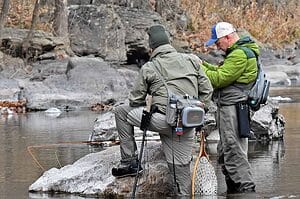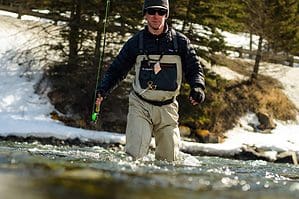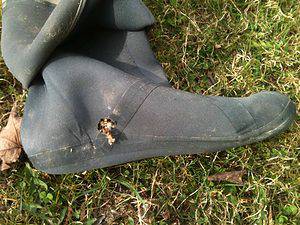Disclosure: Some posts contain affiliate links, which earn us a commission if you make a purchase through them. Positive Fishing © participates in various affiliate networks including the Amazon Services LLC Associates Program.
The technical words and specifications describing fly fishing waders can be mind-boggling. To help make more sense of this, this article hopes to explain all your wader-related questions to ensure you get the right advice before buying.
In this article, I will cover the following:
- Let’s learn what fly fishing waders are, what they are made from, and the different types available
- Learn how to choose the right style for you
- Learn how to take care of waders and last longer
- Help ensure you have all the information when buying waders
What Are Fly Fishing Waders?
Fly fishermen wear waders to protect themselves from the elements while fishing. They enable you to stand in the water without getting wet or cold. Since fly fishermen often spend hours pursuing their sport, waders are essential gear.
What are the Different Types of Waders?

You’ll see anglers wearing different styles when you’re out fly fishing. Whether an angler is on a budget or willing to spend money for the best equipment possible, you’ll find that people have different preferences when it comes to staying comfortable on the water.
What Are Fishing Waders Made From?
The best type of waders are either Neoprene or a nylon/polyester blend.
Neoprene Waders
Neoprene is a thick and pliable synthetic rubber. They are designed to keep you warmer in the year’s colder months. Neoprene is not breathable, and moving around the water is not as easy. If you are constantly moving, then neoprene may not be the best choice; walking could get a little tiring!
Nylon/Polyester Waders
The nylon/polyester blend is a breathable material option. Quality and price will determine the number of layers used in the construction, so choose wisely.
The combination of nylon and polyester allows moisture from sweat to escape easily from the inside of your footwear. The world-renowned material Gore-Tex is commonly used in some of the highest-quality options. Not only does it allow breathability, but it also provides more flexibility as you move around.
Whichever wader type or style you buy, please ensure you know the dangers of wade fishing. Check out my in-depth article regarding Wade fishing safety, yips, and gear to understand the risks and dangers.
What Are The Main Types Of Waders Available?
Hip vs. Chest Waders
Perhaps the easiest decision you’ll have to make is whether you’ll choose hip or chest waders. Hip waders are going to be pants without a waistband, essentially. They’re long enough to cover you almost to your waist and hook up to any pants with a belt loop.
Most anglers will use hip waders if the temperature outside is extremely warm but the water temperature is freezing. If you’re fishing a tailwater, then you’ll find that the water is cold so you want to get chest waders.
The downside of hip waders is that they don’t allow you to wade past your waist. You have to stay in shallower water so you don’t fill your waders and get yourself in trouble.
Regardless of the air temperature, you’ll be better off fishing with chest waders. If it is too hot, you can roll down your chest waders so they hang out more by your waist.
Bootfoot vs. Stockingfoot Waders
There are debates within fly fishing circles as to which type of waders are better. Bootfoot waders have boots built into them. The nice thing about this option is that you don’t have to purchase wading boots to go with your waders! Plus, they will be a bit less expensive than stockingfoot ones. However, these boots are often not as comfortable!
Stockingfoot waders only come with neoprene socks, and you can purchase separate wading boots to go with them. If you’re the type to hike and cover quite a bit of ground when you fish, then it’s not a bad idea to purchase stockingfoot so you can fish exactly where and how you want.
Neoprene vs. Breathable Waders
As mentioned earlier, neoprene waders are more for anglers fishing in cold water and cold temperatures. Neoprene is a thicker and insulated material that makes up wetsuits and many other hunting waders.
Purchasing neoprene waders is not a bad idea if you fish and hunt. However, breathable waders would be your best option if you’re only fly fishing.
Breathable types are more versatile than neoprene waders. Neoprene waders will increase your body temperature and warm you on hotter days. Breathable ones are lightweight and make moving around much more comfortable.
If you’re fishing in colder conditions, you’ll have to put layers underneath your waders to ensure you don’t freeze while fishing in some colder conditions.
What Boots Should I Buy With Stockingfoot Waders?
If you buy stockingfoot waders, you need a pair of wading boots. Most fly anglers choose this option to combine the best of both items.
If your waders get worn on the soles then you will need to replace the complete waders, alternatively changing just the boots is not only cheaper but also the part that tends to wear the fastest.
You can use any boots you wish; most manufacturers, such as Orvis, have boots to match their stockingfoot ranges.
Important Factors In Choosing Waders

Temperature:
In summary, choosing your waders is like most fishing gear – it’s a personal choice. One big factor is where you live and fish. If you fish in the warmer southern areas or only do your fishing in the summer, a lightweight version is best for you. If you fish in the northern areas or during the wintertime, you must buy a thicker wader. The opposite is also true.
Comfort:
Fishing in comfort is also equally important. Being able to move around for several hours is tiring and affects your concentration and ability to catch fish.
Price:
Know your budget; waders are an expensive part of the fishing gear required. Buy the best you can afford.
Tip: Always go to the tackle shop to try some before buying. You can also ensure the size is the right one. Buying online before trying can be somewhat risky.
How Long Do Waders Last Before Replacing?
All waders should last at least five seasons of normal usage. All the waders in my buyer’s guide on the Best fly fishing waders will last up to 7 or 8 years if the right care and attention are given after and before fishing.
How To Make Your Waders Last Longer?
Great waders are probably going to cost more than your rod and reel! So taking care of them is of utmost importance.
Here are a few guidelines to ensure they last as long as possible.
1. Rinse them off once you get home. Just a few minutes using water from a hosepipe will clean off all the mud or debris. Waders do get scratched from small stones etc if needed a simple soap solution can be added to clean off any stubborn areas.
2. After washing, make sure they hang dry. Just clip them to a washing line upside down to remove any moisture.
3. Don’t leave them in direct sunlight for hours or in a hot place like a car. Once they are dry, hang them in your garage or shed till the next time you use them.
4. Just like umbrellas and fishing vests, a coating of direct water repellant is required after some time. You only need to do this waxing every six months. I’d recommend the same NikiWax brand I previously recommended in my article on the Best carp bivvy.
5. Be extra careful when taking them off. Don’t force your feet out of them, as this can cause damage to the neoprene socks. Once removed, ensure there are no small stones or other debris on the bottom of them.
Can Waders Be Repaired?

Unfortunately, there may be times when a small hole or tear appears in the waders—generally caused by sharp stones on the river bed. You can buy puncture repair kits for small holes but always check with the wader manufacturer on the recommended sealant.
The sealer should only be applied in a thin coat on the interior of the waders. Cover the puncture point and surrounding area so the sealant affixes to the fabric.
Gear Aid Aquaseal UV Repair Adhesive is a well-known, excellent choice for repairing all types of waders and boots.
Take note, when buying any option from Orvis, Redington, or Simms, you will get a warranty of up to 12 months.
Final Thoughts
I hope that this article explained what different types of waders are available and also helped you make a better decision on which ones suit your style of fishing. It’s an important decision given the investment.
Now that you know more about waders, please check out my top women’s wader recommendations, which are more unique in style and comfort.
- 5 Best Fishing Bags For Getting Your Gear Organized - January 13, 2025
- 4 Essential Surf Fishing Rigs - January 11, 2025
- How To Know The Sex Of A Fish You Have Caught? - December 9, 2024

